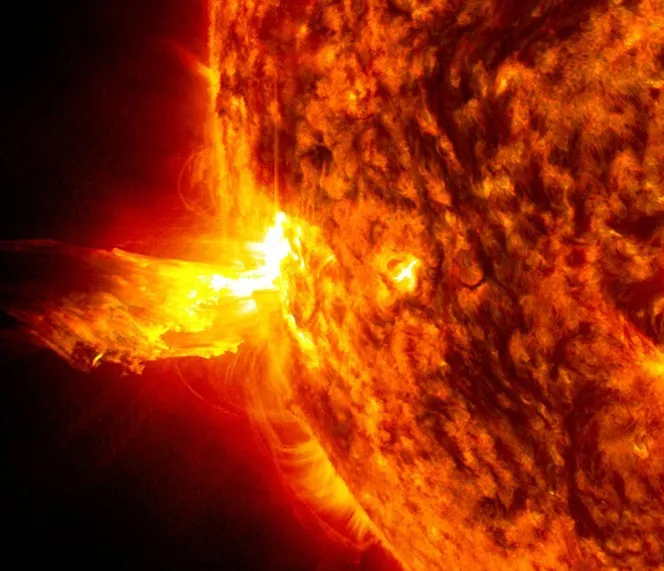Understanding Solar Flares and Their Consequences
As we delve into the complexities of our universe, solar flares—powerful bursts of radiation and energy emanating from the sun—continue to be a topic of concern for scientists and citizens alike. Solar flares can disrupt communication technologies and pose threats to satellite operations on Earth.
Recently, NASA has issued warnings regarding an increase in solar activity, forecasting that several massive solar flares could erupt in the coming months, raising the potential for widespread blackouts. The strongest solar flare recorded thus far in 2025 recently erupted, unleashing a wave of energy that resulted in radio blackouts across Europe, Asia, and the Middle East. Events like these prompt discussions among experts about the implications of solar storms on our daily lives and the technologies we so heavily rely upon.
What Are Solar Flares?
Solar flares are explosive releases of energy that occur on the surface of the sun, driven by the sun’s magnetic field. These flares can release energy equivalent to millions of nuclear bombs, resulting in intense bursts of light and electromagnetic radiation. The energy and charged particles released during these solar events can travel through space and interact with the Earth’s atmosphere, creating various effects including communications disruptions, navigational difficulties, and even potential damage to electrical grids.
The Recent Solar Flare Events
Those observing the sun closely knew we were due for a significant flare given the sun entering an active phase of its 11-year solar cycle. The recent solar flare, classified as X-class—denoting it as one of the strongest categories of solar flares—was recorded on April 15, 2025. This powerful eruption was felt worldwide, causing radio blackouts that frustrated communication channels across Europe, Asia, and the Middle East. Such occurrences unfolded as channels struggled with distorted signals and intermittent connectivity, marking just a fraction of potential disruptions to come.
The flare also sparked heightened auroras, visible in regions closer to the poles, delighting many sky watchers. However, the more serious impacts could be seen in aviation schedules and navigational systems, requiring adjustments amid unstable communications. NASA’s forecasts suggest that we may experience additional flares in the upcoming months, and the situation is likely to intensify.
The Implications for Modern Technology
As we become increasingly dependent on technology, the consequences of solar flares can pose significant challenges. Our communications, GPS systems, and even power grids are susceptible to the effects of solar storms. When solar particles collide with the Earth’s magnetosphere, they can disrupt the natural flow of electricity, leading to blackouts and equipment failures.
In June 2025, an exceptionally powerful solar storm caused communications blackouts across at least five continents. This incident showcased how interconnected our global systems are and how a single event in space can cascade into widespread disruptions on Earth. Despite our advanced technology, vulnerabilities remain, and the need for contingency plans is evident. It brings an urgency to the discussion surrounding the reliability and resilience of contemporary infrastructure.
Energy Grids at Risk
Power grids are particularly at risk during heightened solar activity. An intense geomagnetic storm struck in 1989, causing widespread blackouts in Quebec, Canada. This is a reminder of how even well-developed nations can face significant challenges when Mother Nature decides to unleash her fury. As we progress further into this solar cycle, the threat level rises, compelling utility companies and governmental organizations to enhance grid resilience and preparedness for solar storms.
Potential Recovery Strategies
In response to the recurrent threats posed by solar flares, industry experts and scientists are advocating for heightened preparedness strategies. This includes better forecasting of solar weather events using satellites designed to detect solar activity earlier, which would allow operators to safeguard critical infrastructure.
Another important approach is rigorous research into cutting-edge technology capable of shielding sensitive electronic devices from the impacts of such phenomena. As organizations invest in innovation and solutions, the focus remains on minimizing the fallout during inevitable solar events.
Conclusion: The Onward Journey with the Sun
As we continue to explore and understand the impacts of solar activity on our technological society, we must remain vigilant and proactive. NASA’s warnings serve as a crucial reminder of the need for awareness regarding solar flares and their effects on our lives.
The strong solar flare activity witnessed has not only implications for technology but also serves as a link between the cosmos and daily events. Engaging with solar monitoring, investing in robust communications infrastructure, and fostering international collaboration can help mitigate the impacts of these natural phenomena.
Ultimately, while we bask in the light of the sun, understanding its potential dangers is imperative. The looming potential for more intense solar activity necessitates that we prepare adequately, ensuring that our modern world is equipped to withstand the onslaught of immense cosmic forces.







